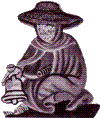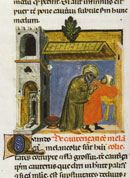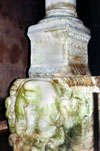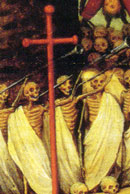The Rise of Christian Tyranny – Ruin of Public Health
Collapse of Ancient Medicine
“There is only one Physician, Jesus Christ.”
– St Ignatius (quoted by S. Argus, p305)
Twilight:
The triumph of ecclesiastic terrorism (see Death on the Nile) signalled the end of Alexandria as an intellectual centre. From the early 5th century onward this greatest metropolis of the Hellenic world dwindled into a Christianised backwater.
With Christian dominion in Egypt came the burial of the dead and the loss of a practical knowledge which, for millennia, had been gained from the mummification of corpses. The victory of religious fanatics signalled the impending closure of the academies of secular study and with it, an end to the formal training of doctors. Any residual knowledge of ancient medical wisdom, passed on by practitioners, was condemned as ‘sorcery’ and this censure extended to attacks upon herbal remedies.
With the victory of Christ, cleanliness and hygiene were themselves suspect. The Church condemned public bathing (as immoral and sinful) as energetically as it did the theatre, and encouraged the closure of the baths which had done so much to preserve public health in the great cities of the Roman world.
‘A clean body and clean clothes betoken an unclean mind.’
(C. Freeman, p238)
Thus spoke the ‘ascetic Paula’, a Roman aristocrat and Christian zealot, to the nuns she had gathered around her. St Jerome, Church luminary and author of the Vulgate Bible, echoed her sentiments:
‘He who has bathed in Christ does not need a second bath.’
Church Father Tertullian found even shaving offensive to God. It was:
‘… a lie against our own faces, and an impious attempt to improve the works of the creator.’
(Gibbon, ch. 15)
But the Roman habit of daily bathing, such a quintessential feature of their culture, took centuries to die. During the 6th century reign of another Christian hero – Justinian – Constantinople’s public baths still functioned. But the numerous baths dated from an earlier age and they had never matched the spectacular structures of pagan Rome.
In the largesse of Justinian’s early years the Bath of Zeuxippus was embellished and another built in the district of Hebdomon. But throughout his reign the Christian monarch’s preoccupation (and the empire’s wealth) was taken up with the construction of a plethora of costly churches, monasteries and convents.
There were no ‘Baths of Justinian’ – Godliness came before cleanliness.
Wars and civil turmoil interrupted urban water supply (and not only to the baths) throughout the Roman world. Starved of funds and with no new engineers being trained sophisticated maintenance of the baths became impossible. During the 7th and 8th centuries, all the grand baths went out of use completely, their fabric pillaged for Christian churches. Church prudishness, which viewed the human body not as a thing of beauty but rather as a temptation, had no regrets about the loss.
Skin diseases – the notorious ‘boils’ and ‘leprosy’ of the Middle Ages – became the norm rather than the exception. Until modern times, almost any disfiguring skin complaint was classed as ‘leprosy.’ Untreated, permanent damage would spread from skin to nerves, limbs and eyes.
Lepers themselves were total outcasts. Once a charge of leprosy was made the hapless soul was banned from towns, markets, even churches. Forced to live outside the main settlements, the leper had to carry a clapper or a bell to warn passers-by of his coming.
Christian ‘charity’ occasionally established a lazar house, not to effect any treatment to the sick but to confine the victims away from other folk. Condemned to this living hell (lepers were known as the ‘dead among the living’) these desperate souls still had their uses. For a certain breed of pious Christian ‘caring’ became an end in itself, the means by which the carer earned his own salvation in the world yet to come.
But at least the sufferers were close to God.
Biblical Guidelines –
God’s treatment for leprosy:
Get two birds. Kill one. Dip the live bird in the blood of the dead one. Sprinkle the blood on the leper seven times, and then let the blood-soaked bird fly off. Next find a lamb and kill it. Wipe some of its blood on the patient’s right ear, thumb, and big toe. Sprinkle seven times with oil and wipe some of the oil on his right ear, thumb and big toe. Repeat. Finally kill a couple doves and offer one for a sin offering and the other for a burnt offering.
(from Leviticus 14:2-32)
6th century Catastrophe – Plague
Bubonic plague first reached the Roman world in the spring of 541 AD. The trigger appears to have been a climatic shift resulting from a massive volcanic explosion on the island of Krakatoa, with atmospheric dust chilling both hemispheres.
Plague-carrying rats arrived first in Roman Egypt at the port of Pelusium and from there spread to Antioch, Constantinople and other cities. The result was devastating:
“Up to a third of Europe’s population died in the first massive outbreak and in the capital, more than 50 per cent of the inhabitants are thought to have perished.”
(Keys, p7)
John of Ephesus recorded that, at it height, in the city of Constantinople, the plague was carrying off as many as 16,000 souls each day. Worse yet: the plague was to return repeatedly over the next two centuries.
Lamentably, the most virulent outbreaks of the plague coincided with the long reign of Justinian. Two centuries earlier the empire might have recovered reasonably quickly from this natural disaster but the vainglorious monarch, preoccupied with re-conquering the west, had plunged the Roman world into almost continuous warfare.
The western provinces were ruined by the conflict. 30 years of warfare against the Goths in Italy, for example, (in which Rome changed hands four times) destroyed urban civilization in the peninsular and brought whole regions to famine. The provinces of north Africa and southern Spain were similarly ravaged by Justinian’s armies. Records Procopius in The Secret History:
“To make any accurate estimate of the number of lives destroyed by this man would never, it seems to me, be within the power of any living being other than God. … Libya, for instance, in spite of its enormous size, has been laid so utterly waste that however far one went it would be a difficult and remarkable achievement to find a single person there … In Libya alone five million people lost their lives …” (18.15)
Yet Justinian achieved no lasting triumph. The wrecked provinces were not rebuilt but rather, were further ruined by the rapacious greed of tax farmers. Their intent was to collect ever-greater amounts of tax to pay for grandiose ecclesiastical buildings and a huge parasitic class of monks. People fled the towns more often to avoid the taxman than the ‘barbarian’.
Even during Justinian’s lifetime, new tribes crossed the weakened frontiers: Lombards, Moors, Slavs, Bulgars, Avars. Harvests went ungathered, livestock roamed free, vast areas of agricultural land went out of cultivation. The hungry, dirty, war-weary and displaced peoples of the Roman world were rendered extremely vulnerable to the virulence of the plague.
Lurch into Pious Madness
But worse was to come. After the death of his wife Theodora in 548, Justinian entered a period (which lasted seventeen years, until his death) of morbid piety.
‘During the last years of Justinian, his infirm mind was devoted to heavenly contemplation, and he neglected the business of the lower world.’
(Gibbon, Chapter 45)
Justinian, God’s ‘Regent on Earth‘, though previously of a contrary opinion, was now reliably informed by the Big Guy that “Christ had only one nature and it was divine” (in Church-speak monophysitism) and launched a new civil war against his obdurate subjects.
While Justinian contemplated the nature of the godhead, his churchmen had their own response to the pandemic: Church hierarchs claimed that the plague was God’s punishment for not obeying church authority.
With this additional whip in the hands of the Church, and corpses piling up in the street, thousands flocked into the churches in a desperation to be “saved” and avoid the lash of God’s Loving Church.
In the climate of terror, one group in particular, was singled out for special treatment: the Jews. Justinian outlawed the Talmud, which he described as ‘puerile fabrications, insulting and blasphemous’ and he curtailed the religious and civil freedoms which they had always enjoyed.
Obstinate pagans were even more harshly dealt with. A fanatical monk and inquisitor, Ioannis Asiacus, was dispatched to forcibly convert any remaining pagans in Asia Minor. Plato’s old academy at Athens was closed and non-Christian philosophers fled into exile. Homosexuality was outlawed.
Justinian (rather like Stalin in 1953) died just as he was about to launch a new purge, this time eliminating opponents of his latest theological marvel – ‘aphthartodocetism’ (apparently, ‘JC had always had an “incorruptible” body, not able to feel hunger, thirst or pain.’)
But there was no denying the demographic disaster that had befallen the Roman world. Constantinople, in the years before the plague a city of half a million souls, a century later had a population of barely 100,000. By the end of the 6th century the population of Europe had halved and many towns had simply ceased to exist.
The Christian Empire’s response was pious madness …
Bizarre beliefs about the human body.
Bizarre treatments:
“Christian medicine”
Christians have always had a special affinity with suffering. Their godman suffered for the sins of the world and in every age, hair-shirt Christians have embraced suffering as a way of getting closer to their hero. Contrariwise, pleasure has always been somewhat suspect, particularly ‘desires of the body,’ regarded as demonic in origin. Greek Stoicism, of course, had urged continence and emotional restraint but Christians took the idea to new extremes.
In their psychotic mind-set, many Christians regarded the body as nothing less than the ‘enemy’ of the soul. The demons who inspired desire were to be fought in what was perceived as a cosmic battle for the soul. Though its own hierarchs rarely observed the practice, subjugation of desire, renunciation of pleasure, chastity, self-inflicted agonies, isolation and every other form of deprivation was lauded by the Church as an achievement of holiness and “spirituality.”
The suffering of martyrs – real and invented – became an edifying obsession. The wild ascetics of the desert, the anchorites in caves, the stylites on pillars became creatures of wonder and inspiration.
What did it matter if the cities of man crumbled into the dust, the ‘City of God’ was eternal. What did it matter if, in this short life, you were sickly and crippled, you would be perfect in God’s kingdom for all eternity. Since God creates all things, even sickness and injury is by His Will. Who are we to question the Divine plan? To cure sickness, to repair injury, with the ‘wisdom of man’ was to oppose the Will of God.
In the ecclesiastic asylum of the post-classical age, the ancient medicine and hygiene of the Greeks and Romans were declared ‘heretical’, having been overwhelmed by the plague in any event. In the aftermath of the plague the Church moved to dominate all fields of medicine. Holy Mother Church delimited the acceptable response to illness:
– the sick were to repent for their sin (which had allowed malevolent spirits to enter their body);
– the sick were to be sent on pilgrimage to a holy shrine (where they could purchase relics);
– the sick were to write holy names on scrolls and wear them on the body;
– prayers were to be offered up to the Saints.
It seems martyrs’ bones were capable of curing everything (but, of course, not everyone). Monasteries in both east and west had so-called ‘hospitals’ and ‘sick houses’, though essentially they were hospices, where ignorant monks aided the sick to die with a “saved” soul. A legacy bequeathed to the Church was the most assured method of ensuring passage to the Christian Heaven.
Much of the Roman world had been uneasy about dissection (such was the fear of the dead). The Church was in no doubt: dissection of the human cadaver was “a desecration of the Temple of the Holy Ghost.” Medical research ceased for a thousand years.
It should be noted in passing that the Church’s interdict on the dissection of the human body was of no import when it came to the chopping up of ‘saints’ cadavers. An essential element of Papal Catholicism’s foreign policy – and “fund raising” – was the export of martyrs’ bones and relics to its religious colonies. The various parts of a ‘martyr’ might be distributed across the length and breadth of christendom. Indeed, the Church quite consciously used the disturbing ‘power’ of skeletons to instill fear and awe in whole nations lost in ignorance and superstition.
Vale of Tears
Byzantine medicine, during the course of centuries, showed neither originality nor innovation. The long and often complex medical writings of antiquity, though occasionally copied and abridged, did little to mitigate the epidemics which regularly decimated the increasingly unsanitary cities. Leprosy, smallpox and tuberculosis all took their toll.
In the west, the picture was even bleaker. Though a physician is occasionally reported at the court of a barbarian king, ‘medicine’ had become entirely the province of an ignorant, chanting clergy, and, among the peasantry, of ‘wise women’ – custodians of folk wisdom and herbalism, forever in danger of denouncement by the Church for ‘sorcery’. Their efforts, in time, were to make them the victims of witch-hunts and barbarous cruelty.
The best that could be said is that successive culling of the human population ensured that a natural resistance was passed on by the fortunate survivors.
‘Sharing Christ’s Suffering …’

“There is an alarming account of the dead Thomas à Becket …
Apparently the Archbishop of Canterbury wore a large brown mantle over a white surplice, over a lambs wool fur coat, over a woollen pelisse, over a Benedictine habit, over a shirt, over a tight-fitting hair-cloth suit.
All those were infested with fleas, bugs and lice, so many that the garments seemed to be moving.”
– Cochrane (The Illustrated History of Medicine p38)
Humorous Medicine
‘Greek medicine’ – that is the medicine of the Roman world – trickled back into the west over several centuries. After a darkness of 500 years, contact with the Muslim world, which had preserved and translated into Arabic many ancient manuscripts, led to re-translation into Latin of the works of Galen in particular.
‘Constantine the African’, a multilingual convert to Christianity from Carthage, became a monk at Monte Casino, where he made available Latin versions of Galen’s Ars parva, Hippocrates’ Aphorisms, and ‘Haly Abbas’s’ Pantegni.
‘With these works Western Europe now had available to it details of the theoretical medical system – Galenism – developed in antiquity.‘
– I. Loudon (p56)
From Monte Casino the knowledge went south to Salerno where, about the year 1100 the first medieval medical school began. Others followed at Chartres, Paris and Montpelier. The fall of Constantinople in 1453 dispersed to the West many Greek scholars and with them, many precious manuscripts from a pre-Christian world.

The Muslim scholar Ibn Sina (given the Latin name “Avicenna” to make him more palatable to the Church) wrote an encyclopedic compilation of ancient medical wisdom in the 11th century. His Canon of Medicine formed the curriculum of European medical schools until the 17th century.
During these centuries Christian Europe showed its gratitude by waging a series of vicious Crusades against the infidel.
But whereas the 2nd century Galen had been an empiricist, ready to revise both his theories and practice, the poorly-educated quacks of the Middle Ages, who re-discovered Galen 800 years after his death, were awe-struck by his prodigious output.
Under the suspicious eye of Holy Mother Church they could do no better than ‘systematize’ Galen’s speculations on ‘humours’ into a pseudo-science, which combined liberal doses of alchemy and astrology with a limited scientific understanding. Four ‘qualities’ (hot, cold, dry, wet), permutated with four ‘elements’ (fire, air, earth, water), produced four ‘humours’ (blood, phlegm, yellow bile, black bile) which, when, in imbalance, caused illness – or so it was thought. In this crippled form, ‘Galenism’ formed the medicine of Europe for the next 600 years.
Bloodletting
Thanks to mediaeval Galenism, Christian monks and nuns learned ‘bleeding’ techniques, designed to prevent ‘toxic imbalances’ and restore ‘humours’. As a result, tens of thousands died each year by bleeding until the practice ended in the 16th century.
An equally ludicrous alternative to bleeding was blistering – ‘drawing off sick or excessive humour with a hot iron’ and with it, concoctions of lead, arsenic and cow dung, all used to treat disease! Throughout the lethal ‘treatments’, of course, religious penance and prayer played a central role. We were all doomed to die anyway.
The 4th Lateran Council of 1215, the first to prohibit bishops, abbots and priests from performing surgery, required physicians (themselves members of minor orders) to get their patients to confess sins to a priest before administering treatment, because:
‘anima sit multo preciosior carpore’
(the soul is far more precious than the body)
The same rationale, in fact, used to justify centuries of killing wherever ran the writ of Christ’s Loving Church.
Postscript: Christian Prudery’s Gift to the World? – Syphilis
“A mysterious epidemic, hitherto unknown, which had struck terror into all hearts by the rapidity of its spread, the ravages it made, and the apparent helplessness of the physicians to cure it.”
A quote about AIDS? No. It’s about the appearance of syphilis in the early 16th century. Despite the popular myth we now know syphilis was NOT brought back by Columbus and his libidinous crew after 1492. Syphilis had been endemic in Europe for millennia.
The evidence comes from pre-Columbian skeletons – such as those unearthed at an Augustinian friary in Hull (see BBC History) – and from a 14th century churchyard in Essex (see Secrets of the Dead) – which show the distinctive malformations of syphilis. In Hull, 60% of the excavated skeletons showed signs of syphilis. Other pre-Columbian skeletons with signs of syphilis have been found as far afield as Pompeii and Israel.
Syphilis existed in Europe prior to the 1490s but was unrecognized and in a form which was less virulent, and was confused with other diseases such as leprosy. The name ‘syphilis’ was first applied by Girolamo Fracastoro in 1530 from the name of a shepherd in a poem by Leonardo da Vinci. The syphilis bacterium – the Treponema microorganism – had been causing related diseases, like yaws or bejel, for thousands of years – on both sides of the Atlantic.
But in the late 15th/early 16th centuries, unique conditions favoured a mutation of the microorganism into a sexually transmitted disease.
Evolution of Syphilis towards sexual transmission
Infections are more pathogenic when they arrive in virgin populations – as was the case when other European diseases were introduced into the New World: small pox, typhoid, scarlet fever, influenza, dysentery, diphtheria, chicken pox and cholera. Pre-contact American Indian healers – with a system of medical treatment comparable to European physicians of the time (botanical antiseptics, syringes made from bird bones) – were completely overwhelmed by the assault. Many populations of native Americans were themselves decimated by syphilis in the 16th century – after the arrival of Europeans. An estimated 65 percent or more of American Indians died within a century.
Before the 15th century, a non-venereal treponomal organism existed in the Americas as a relatively harmless childhood disease, endemic in rural areas, and transmitted by skin contact between naked children. Taken back to European cities by the early mariners the disease subsequently mutated into a sexually transmitted disease in order to facilitate its survival in the colder, non-tropical climate. In Europe, the wearing of clothes, even in childhood, inhibited survival of the non-venereal strain whereas promiscuity in over-crowded port cities favoured the natural selection of an organism efficient at sexual transmission. The disease we know today as syphilis emerged. It was then re-exported to the Americas in its newer, deadlier form.
Making matters worse, was Christian morality, which forced the native peoples into clothing to hide their ‘shame’. One might reasonably suppose that had the custom of ‘light’ dressing of the Greeks continued, a lack of shame about nudity remained the norm, and had the great bathing establishments of the Romans remained in service, the world might not have endured the scourge of syphilis.
Sources:
Peter Murrey Jones, Medieval Medicine (The British Library, 1998)
I. Loudon (Ed.), Western Medicine (Oxford, 1997)
David Keys, Catastrophe (Century, 1999)
John Julius Norwich, Byzantium (Viking, 1988)
Charles Freeman, The Closing of the Western Mind (Heinemann, 2002)
Jenifer Cochrane, The Illustrated History of Medicine (Tiger Books, 1996)
Norman Cantor, In the Wake of the Plague (Pocket Books, 2001)
R.I.P.
Christians Bury Wisdom

Mummification rituals provided the Egyptians with a detailed understanding of human anatomy, which allowed medicine to develop.
With Christianity’s triumph came the burial of corpses and the loss of all such knowledge.
Game OFF

Roman doctors kept athletes fit for the games and in the process became familiar with the human body in prime condition.
In 393 Christian fanatic Emperor Theodosius I abolished the games.
Gym Babes
No More …
The pagan Romans were less concerned with their immortal soul than their mortal body.
“A person should put aside some part of the day for the care of his body. He should always make sure that he gets enough exercise especially before a meal.”
– Celsus, pagan philosopher.
As great believers in ‘a healthy mind is a healthy body’ the pagans reasoned that if you kept fit, you would be more able to combat illness.
How frightfully secular!

Tlos
On Your Knees
Among the earliest basilicas converted to Christian churches (as for example at Tlos, Asia Minor) were ‘gyms’ (palaestra) which had been used for wrestling and physical training.
The immorality of naked athleticism was replaced by hours spent on knees in prayer.
Much better.
And We Don’t Need This

Ruins of Asclepeium at Epidaurus, closed by Christian fanatics in 375 AD.
The asclepeia were temple/hospitals which offered an holistic approach to medicine. How foolish.
Biblical Guidelines –
Avoid Exercise!
“But refuse profane and old wives’ fables, and exercise thyself rather unto godliness.
For bodily exercise profiteth little: but godliness is profitable unto all things, having promise of the life that now is, and of that which is to come.”
– St Paul (1 Timothy 4.7-8)
New for Old
With the triumph of the new sun god, Jesus Christ, the reign of the old sun god, Apollo, came to a close.
Benedict of Nursia had Apollo’s temple on Monte Cassino destroyed and built a monastery in its place.
In Rome, the great temple of Apollo on the Palatine Hill was also demolished. On the same spot, with the same stones, a church was built consecrated to St Sebastian, Like Apollo he was hailed as protector against the plague.
Similarly, the Dioscuri, the twins gods Castor and Pollux of the Romans, were supplanted by saints Cosmas and Damian, physicians and medical missionaries – mythical martyrs but none the less, patron saints of medicine.

Justinian drowns the old sun-god: Apollo’s giant head, inverted, props up a column in Constantinople’s biggest water tank.
540-94 Plague
100,000,000 people died during plagues which sweeps northward from Egypt and Syria.
The European population was halved and the Roman Empire never recovered..
Disgrace
‘The triple scourge of war, pestilence, and famine, afflicted the subjects of Justinian; and his reign is disgraced by a visible decrease of the human species, which has never been repaired in some of the fairest countries of the globe.”
– Edward Gibbon (Decline & Fall, ch. 43)
Christ Rules – The Age Of Disease
“The typical peasant family of the aptly-named Dark Ages lived in a one-room, dirt-floor hovel, with a hole in the thatched roof to let out the smoke of the central fire.
The floor was strewn with hay or rushes, easy havens for lice and vermin. Garbage accumulated within.
If they were lucky, the family had a chamber pot, though more likely they relieved themselves in the corner of the hovel or in the mire and muck outside.”
Christian Europe:
The great age of lice and rats, of plague and epidemic!
Christian Response
to Plague …

Prayer! In this case, to 14th century Saint Roch who was believed to bring relief to plague sufferers.
It seems Roch himself caught the plague while on a pilgrimage to Rome. He was cured by an angel dressing his sores and a stray dog bringing him food. Good dog.
Christian Response to Toothache …

Prayer! In this case, to Saint Apollonia, supposedly a 3rd century virgin martyr from Alexandria. She was martyred, it seems, by having all her teeth violently extracted and thus, by a curious logic, is the patroness of dentistry!
Christian Response to chilblains:

Prayer! Saint Benignus of Dijon. The yarn with this guy was that he refused to sacrifice to pagan gods or deny Christ and in consequence endured savage tortures (perhaps to his feet).
How Many levels of Nonsense … ?
‘John of Beverly (d.721) chastised the nuns of Watton for not knowing that it was perilous to bleed a patient during the moon’s waxing.’
(M. McVaugh, Western Medicine, p55)
Christ Art

Triumph of Death
Brueghel (c. 1562)
